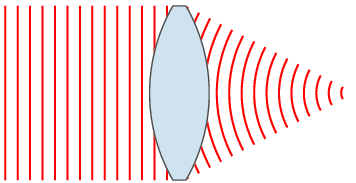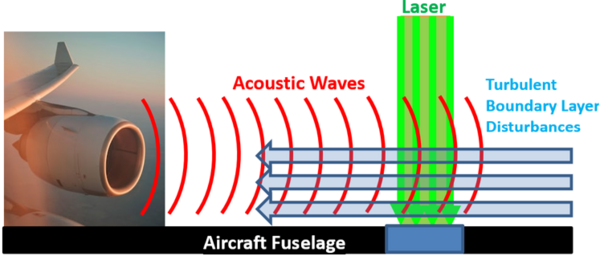Wavefront Sensing

Much of the work done in the Aero-Optics lab is to develop and improve wavefront sensing devices and techniques.
A wavefront is a surface of constant phase in a propagating beam. So for a collimated beam, this would be a flat cross-section, while if you passed that beam through a lens you would then have a spherical wavefront. Being able to measure a wavefront has many uses. For an adaptive optics system, knowing the wavefront allows you to create a feedback loop to update the deformable mirror and correct the beam. For experiments measuring the wavefront of a beam passed through flow in a wind tunnel gives insight into the density field of the fluid and allows you to see structures like vorticies of a shear layer connecting by.
Acoustic effects
During some testing done on AAOL it was shown that acoustic waves generated by the plane's jet engine traveling up stream could be seen in wavefronts taken. Through frequency and modal analysis the acoustic waveform could be separated from the boundary layer content which allowed for cleaner measurement of the boundary layer effects

The original measured wavefront has aberration both from the upstream moving acoustic waves and downstream moving boundary layer disturbances. (This wavefront has a hole missing from the middle because a cassegrain telescope was used to reduce the beam diameter, which has a mirror blocking the center)
Once the acoustic content was removed, the boundary layer disturbances could be analyzed.
Shock-Tolerant Wavefront reconstruction
In supersonic flows shocks will form which create a large change in density over a very small distance. This strong density change breaks down the performance of the Shack-Hartmann wavefront sensor. Our group is working to understand how this affects our measurement and how we can account for it. To do this we have been measuring the WF of a beam passed through the transonic shock forming over a cylinder in Mach 0.5 flow.

Ultra high speed analog wavefront sensor
We developed, built, and tested an analog wavefront sensor that allows us to measure wavefronts at over 100 kHz! Fast wavefront measurement is especially important for adaptive optics systems where the rule of thumb is that you need to be able to measure 100x your desired correction rate in order to be able to make accurate corrections. For an aircraft in cruise at Mach 0.8 you may see structures moving by at a rate of kilohertz, in which case you would have to measure on the order of hundreds of kilohertz! As you go faster this requirement only increases. An analog sensor allows us to skip over much of the processing involved in camera based sensors and thus get higher speeds. We are continuing to work to develop this sensor to push the limits of wavefront sensing.


Shaddy Abado, Stanislav Gordeyev, Eric J. Jumper, "Two-dimensional high-bandwidth Shack-Hartmann wavefront sensor: design guidelines and evaluation testing," Opt. Eng. 49(6) 064403 (1 June 2010) https://doi.org/10.1117/1.3454383